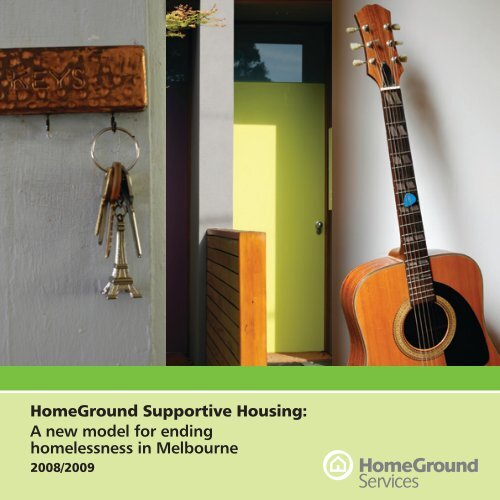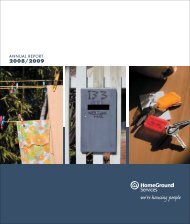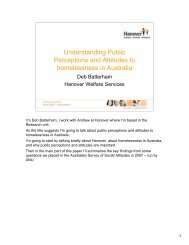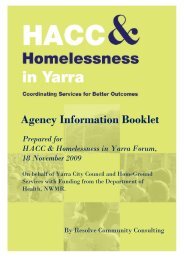HomeGround Supportive Housing - HomeGround Services
HomeGround Supportive Housing - HomeGround Services
HomeGround Supportive Housing - HomeGround Services
- No tags were found...
Create successful ePaper yourself
Turn your PDF publications into a flip-book with our unique Google optimized e-Paper software.
<strong>HomeGround</strong> <strong>Supportive</strong> <strong>Housing</strong>:A new model for endinghomelessness in Melbourne2008/2009
<strong>HomeGround</strong><strong>Supportive</strong> <strong>Housing</strong>represents a newapproach to endinghomelessness throughcollaboration betweenstate and localgovernment, business,philanthropy andagencies.Homelessness canbe prevented.It can be ended.<strong>HomeGround</strong> <strong>Services</strong> is bringing aninnovative new approach to housinghomeless people in Melbourne.<strong>HomeGround</strong> <strong>Supportive</strong> <strong>Housing</strong> will helpend homelessness for the most vulnerable,chronically homeless people.<strong>HomeGround</strong> <strong>Supportive</strong> <strong>Housing</strong>:• is permanent –offering self contained, high qualityhousing• is safe –controlled access keeps unwelcomepeople out• is affordable –with rents set at a maximum of30% of income• has on site supports –to help people settle into and sustaintheir housing• has a social mix of tenants –ensuring a thriving community© Copyright <strong>HomeGround</strong> <strong>Services</strong> 2008All rights reserved.Photographs by Ponch Hawkes.2 3
Message from the CEOMelbourne is globally recognised as one of theworld’s most liveable cities. Our love of sport,dynamic arts scene, great food and wine andparks and gardens are celebrated in postcards.But that liveability is not enjoyed by allMelbournians.While many know the MCG is Melbourne’s homeof sport, few know that 15 out of every 1,000inner-Melbourne residents do not have a home.In Victoria in 2004 there were more than 20,000homeless people, 14,000 of those in inner-Melbourne. At <strong>HomeGround</strong> <strong>Services</strong>, our visionis to end homelessness in Melbourne.When a person is homeless it is nearly impossiblefor them to feel safe, find and keep a job,complete treatment for substance, mentalhealth or other problems, break down negativeconnections, reconnect with family and friends,or to even have hope.<strong>HomeGround</strong> <strong>Supportive</strong> <strong>Housing</strong> – based on amodel developed and effectively implementedin the United States – fills a gap in the way wecurrently deal with homelessness.However we can’t realise our vision of endinghomelessness alone. Working with the privatesector, philanthropists and government we hopeto build <strong>HomeGround</strong> Supportvie <strong>Housing</strong>, amodel project that can create a national evidencebase for further action and help get people – andkeep people – housed.Stephen NashCEO <strong>HomeGround</strong> <strong>Services</strong><strong>HomeGround</strong>’s CEO is a founding member and Chair of the AustralianCommon Ground Alliance (ACGA) a national network of organizationsworking towards ending chronic homelessness in Australia through a mixof solutions – including <strong>Supportive</strong> <strong>Housing</strong> – that build on and adaptprograms developed and delivered effectively by Common Ground NewYork. Melbourne’s “Elizabeth St Common Ground <strong>Supportive</strong> <strong>Housing</strong>”is based upon the Common Ground <strong>Supportive</strong> <strong>Housing</strong> model.ACGA, together with its patron Therese Rein, is committed topromoting and supporting further Common Ground <strong>Supportive</strong><strong>Housing</strong> developments around Australia.A snapshot of theproblem:• 149 out of 10,000 people in inner-Melbourne are homeless• Homelessness is a major social issue,yet it is invisible to most Melbournians• Chronically homeless people havecontact with community services,hospital, justice and mental healthsystems in disproportionately highnumbers• Targeting the most chronicallyhomeless reduces costs to thesegovernment-funded services• <strong>Supportive</strong> <strong>Housing</strong> – housing thatalso provides a diverse mix of supportservices – can help reduce costs.Solutions at a glance:• Different agencies have used differentstrategies to try to house homelesspeople with a measure of success,yet homelessness remains asignificant issue• <strong>HomeGround</strong> <strong>Services</strong> recognised anew model and approach is needed• <strong>HomeGround</strong> <strong>Supportive</strong> <strong>Housing</strong>addresses two key issues – provisionof housing and the provision ofsupport services• <strong>HomeGround</strong> <strong>Supportive</strong> <strong>Housing</strong>will cost significantly less than othertenant based facilities such as jails,hospitals, mental health facilities andeven shelters• This combination of long-termhousing and on-site around-the-clockconcierge and support services doesnot exist in Victoria• Offering homeless people access tosafe, affordable housing is the firststep to ending their homelessness• <strong>Supportive</strong> <strong>Housing</strong> looks like everyother type of housing because it is likeother housing.4 5
Not only does <strong>Supportive</strong> <strong>Housing</strong> provide people witha key to unlock the door to their new home but alsoprovides access to tools on how to live their new life.<strong>HomeGround</strong> <strong>Services</strong>Responding tohomelessness inMelbourneHomelessness is an issue invisible to mostMelburnians yet in 2003-04 almost 35,000people used homelessness assistance servicesin Melbourne.The key elements that create <strong>Supportive</strong><strong>Housing</strong> already exist in Melbourne. What isnew – and underlies the <strong>Supportive</strong> <strong>Housing</strong>model – is the effective combining of them toget a better outcome.The <strong>HomeGround</strong> <strong>Supportive</strong> <strong>Housing</strong> Modelwill target people experiencing primaryhomelessness, the chronically homeless whoare most vulnerable and who have the leastcapacity to cope with, and recover from, risksposed to their wellbeing.Support servicesFlexible and responsive to the needsof the individualMelbourne’s first <strong>Supportive</strong> <strong>Housing</strong> site, tobe located at 660 Elizabeth Street, will be inthe inner-city, located close to parks, publictransport, shopping, health, employment andsocial services.When responding to people who are homelessit is vital to comprehend the full impact ofissues they are juggling such as vulnerablehealth states, repeated experiences of trauma,limited access to sustainable and affordablehousing, insufficient income for basic needs,finding employment, and the loss of family andpersonal relationships.The <strong>HomeGround</strong> <strong>Supportive</strong> <strong>Housing</strong> Modelis a multi-faceted approach that sensitivelyand directly addresses the complex issues andimpacts of homelessness.<strong>Housing</strong>Affordable to people with verylow incomes<strong>Supportive</strong> <strong>Housing</strong>:fitting the MelbournelandscapeHomelessness causes damaging, long termimpacts. Significant proportions of peopleacquire mental health and substance abuseproblems after becoming homeless.Chronically homeless people presentin disproportionately high numbers toemergency health and mental healthsystems for treatment, often for symptomsassociated with their homelessness. Thesesame people are also over-represented in thejustice system and often struggle to breakaway from the cycle of crime due to theirongoing homelessness.<strong>HomeGround</strong> <strong>Supportive</strong> <strong>Housing</strong> meetsthe State Government’s Fairer Victoria policyand fills the gap in the types of housing andservices available to the chronically homeless.At the same time it complements theVictorian Government policy emphasisingthe need for improved connectednessbetween services, better understandingof clients’ needs and achieving long-termoutcomes for people.The principles of<strong>HomeGround</strong><strong>Supportive</strong> <strong>Housing</strong>:• Permanence and affordability• Safety and comfort• On site support services areaccessible and flexible and targethousing stability• Empowerment and independence• Service system linkages andcapacity building.Available as and when needed bythe tenantIndependent with tenants in theirown apartmentsAccessible where the tenant livesPermanent with occupancy to be providedas long as the tenant pays their rent andcomplies with the terms of the lease8 9
Case study:Amanda, 32 years oldCase study:Jack, 54 years oldDiagnosed with psychosis, evicted fornot paying her rent, and with a historyof sleeping rough, Amanda was referredto <strong>HomeGround</strong>’s <strong>Housing</strong> MentalHealth Pathways Program by the socialworkers at St Vincent’s Hospital’s acutepsychiatric ward.Not linked into any services and with ahistory of alcohol and cannabis use thehospital ordered a forensic assessmentto identify if Amanda was safe to live inthe community. Due to her vulnerability,<strong>HomeGround</strong> was able to ensureAmanda stayed in hospital until the bestpost-hospital housing and support wasidentified and available.In May 2007, Amanda was discharged totransitional housing, receiving ongoingassistance from <strong>HomeGround</strong> to assistin understanding and managing herpsychosis, gaining independent livingskills training, re-establishing connectionswith family members, and developingeducational and vocational goals.Since her discharge from hospitalAmanda has maintained her tenancy,enrolled in a TAFE course and startedworking part-time enabling her to savemoney to visit family interstate.Having developed trust in her<strong>HomeGround</strong> Support Worker, Amandacommunicates when she is unwell oranxious and uses strategies they havedeveloped together to prevent a returnto the inpatient unit.<strong>HomeGround</strong>’s <strong>Housing</strong> Mental HealthPathways Program will continue tosupport Amanda as she waits for anoffer of public housing. At that time,<strong>HomeGround</strong> will again be there for herto assist in her relocation and settlementin a new community.Having been made redundant, Jack notonly lost his job but also his home that waslocated on site. With a history of alcoholabuse and no family, Jack relocated fromWA to Melbourne where he was living ata private boarding house in St Kilda.When <strong>HomeGround</strong> <strong>Services</strong> met Jack hewas paying $160 a week for shared kitchenand bathroom facilities at the boardinghouse where on pension day he wasfrequently robbed by other residents dueto his frailty, age and alcoholism.The Royal District Nursing Service fromInner South Community Health Serviceintroduced Jack to <strong>HomeGround</strong>’sHomeless Outreach Worker and within afew days a public housing application hadbeen completed. Three weeks later Jackwas offered a public housing bed-sit.The next step is getting Jack a kitten, as hesaid that if he can pat an animal once aday, he is happy.10 11
Case study:660 Elizabeth Street, the first home of<strong>HomeGround</strong> <strong>Supportive</strong> <strong>Housing</strong>In April 2008, a site at the edge of theCBD was announced as the future homeof <strong>HomeGround</strong> <strong>Supportive</strong> <strong>Housing</strong>.A partnership between the VictorianGovernment, YCH and developer Grocon,will transform the site into a home foraround 120 people, with <strong>HomeGround</strong><strong>Services</strong> providing the associated health,training, support and employmentservices to be located on site.April 2008 site launchArtist’s impression>Grocon generously announced it wouldconstruct the facility at cost, a significantcontribution while <strong>HomeGround</strong> <strong>Services</strong>will co-ordinate the provision of health,legal, educational, recreational, wellnessand support services together witharound-the-clock security andconcierge services.Further support for this pioneering initiativecame in the shape of a $3.1 million (overfour years) allocation to fund servicedelivery at 660 Elizabeth Street, partof the 2008-09 Victorian Budget.Making the modelwork in Melbourne<strong>HomeGround</strong> <strong>Supportive</strong> <strong>Housing</strong> representsa new approach to ending homelessnessthrough collaboration between state andlocal governments, business, philanthropyand agencies.An imaginative model, it looks to providesocial connectedness for the formerlyhomeless and provide a dynamic social mix.To achieve this, <strong>HomeGround</strong> <strong>Services</strong> isdeveloping a coalition of partners that willbuild on existing links between interconnectedservice systems and government, and willprovide a body of experience and expertisewithin Melbourne.Rosanne Haggerty founder and presidentof Common Ground, a leader in <strong>Supportive</strong><strong>Housing</strong> in the USA has an internationalprofile, successfully influencing government,business and philanthropy to create <strong>Supportive</strong><strong>Housing</strong> in various parts of the USA as well asin other part of the country.<strong>HomeGround</strong> <strong>Services</strong> has developed arelationship with its American counterpartand hosted Rosanne during her November2007 visit to Melbourne to address sectorforums, meet with government, and advocatethe benefits of <strong>Supportive</strong> <strong>Housing</strong>. A monthlater, several <strong>HomeGround</strong> <strong>Services</strong> staffvisited <strong>Supportive</strong> <strong>Housing</strong> projects inLos Angeles and New York. This informationsharing and knowledge transfer has clarifiedthe success and potential of <strong>Supportive</strong><strong>Housing</strong> and solidified <strong>HomeGround</strong>’s resolveto actively influence the development of<strong>Supportive</strong> <strong>Housing</strong> models in Melbourne.In March 2008, on a visit to New York,Thére`se Rein, wife of the Australian PrimeMinister, Kevin Rudd, stopped in at theCommon Ground project. Impressed bythe facility and the benefits it delivered itsformerly homeless residents, she indicated hersupport for bringing the concept to Australiaand subsequently was announced Patron ofthe Australian Common Ground Alliance,a national network founded by<strong>HomeGround</strong> <strong>Services</strong>.The <strong>HomeGround</strong> <strong>Supportive</strong> <strong>Housing</strong> Modelis not just about the dwellings within whichpeople live but the support services theyreceive and the connections they maketo the community around them. It is aboutcreating a sense of belonging in a home anda community.12 13
Who will benefit?<strong>HomeGround</strong> <strong>Supportive</strong> <strong>Housing</strong> will havea real impact and help stabilise life forthe chronically homeless and those mostmarginalised. It will also reduce the impost onpolice, health, mental health and homelessservices and allow formerly homeless peopleto participate more fully in society.<strong>HomeGround</strong>’s <strong>Supportive</strong> <strong>Housing</strong> Modelaims to:• maintain stable housing for tenantswho were once homeless or at riskof homelessness• increase tenant participation insubstance use and mental healthtreatment services• improve the health and wellbeingof its tenants• increase tenant participation in thecommunity• increase tenant participation in jobtraining and secure employment• contribute to the diversity of innerMelbourne as a vibrant and supportivecommunity.It is an imaginative model that provides socialconnectedness and a dynamic social mix forthe formerly homeless.Understanding<strong>Supportive</strong> <strong>Housing</strong>Originating in the 1960’s, the American<strong>Supportive</strong> <strong>Housing</strong> movement inspires<strong>HomeGround</strong>. Over the past 20 years,<strong>Supportive</strong> <strong>Housing</strong> – combining affordableaccommodation with support services –has become a dynamic, flexible and robustmodel that meets the needs of marginalizedhomeless populations. Cost-effective, itsgreatest outcome has been in human termsfor individuals, families and the communitieswithin which they live.Hugely effective in the USA where there aretens of thousands of <strong>Supportive</strong> <strong>Housing</strong>units developed and operated by non-profitorganisations, ranging from units in singlefamilyhomes to single site developments ofseveral hundred units each.In many ways <strong>Supportive</strong> <strong>Housing</strong> is likeother forms of housing – it typically looksand functions exactly the same way as anykind of permanent housing for any individualor family. The exception is that tenants haveaccess to on site support services and 24-hoursecurity controlled access to the site.Key elementProperty development, ownership andmanagementTenancy managementConciergeSupport servicesAt 660 Elizabeth Street, the future homeof <strong>HomeGround</strong> <strong>Supportive</strong> <strong>Housing</strong>, anaround-the-clock concierge service will ensureaccess to the building is controlled, protectingresidents and promoting wellbeing.Functions/ActivitiesAsset management and developmentProperty maintenanceTenancy sign upRent collectionProperty terminationCoordinating property maintenanceControlled accessMeet/greetDay to day awareness/ familiarity/friendliness towards tenantsTenant selectionIntake and assessmentEngagement with tenantsRelationship buildingCoordinating services on siteOngoing support and case planningCoordination with tenancy managerCoordinating allied health, therapeuticand visiting professional sessionsFor <strong>Supportive</strong> <strong>Housing</strong> to be effectivepartnerships are needed – with supportservices, government agencies, health providersand the broader community. Workingcollaboratively ensures optimum outcomes areachieved for the people being housed as wellas the agencies delivering the services.1415
Who would be a<strong>HomeGround</strong> <strong>Supportive</strong><strong>Housing</strong> resident?Residents of 660 Elizabeth Street willcomprise 50 per cent (previously)homeless people and 50 per cent ofpeople with low incomes who work orstudy in the local area. Mixing peoplewith different abilities, genders, needs,ages, income levels and household sizesensures greater diversity and normalityin the housing environment, provides agood fit in the community, and integratespreviously homeless people into thewider community.The <strong>HomeGround</strong> <strong>Supportive</strong> <strong>Housing</strong>Model provides for single people andcouples who are:• experiencing chronic homelessness• cycling through institutional andemergency health and mentalhealth systems• facing persistent obstacles togaining access to and maintaininghousing, such as mental healthissues, substance use issues, otherchronic medical issues and otherchallenges• being discharged from institutionssuch as jails• without stable housing and havedifficulty accessing and continuingto use treatment and supportservices• the most vulnerable (singles andcouples) and most likely to beexploited in boarding houses,community managed roominghouses or on the street• low income earners for whommarket rents are unaffordable.How <strong>Supportive</strong><strong>Housing</strong> works<strong>Supportive</strong> <strong>Housing</strong> is the combination ofthree interdependent elements – propertydevelopment, tenancy management andsupport services. To successfully deliver<strong>Supportive</strong> <strong>Housing</strong> a robust collaborationand coordination between these threeelements is needed.Where these elements are delivered bydifferent agencies, a commitment topartnership must exist. This collaborative,innovative approach to partnerships shouldextend to the wider network of otherstakeholders, including services and tenants.<strong>HomeGround</strong> <strong>Services</strong> has a long history ofcollaborative relationships and knows theseare the most efficient way to combine skills,knowledge and expertise and the diverseneeds of <strong>Supportive</strong> <strong>Housing</strong> tenants.Each of the three individual functionsrequires a provider with different expertise.What difference can<strong>HomeGround</strong> <strong>Supportive</strong><strong>Housing</strong> make?Responding to homelessness holistically sets<strong>Supportive</strong> <strong>Housing</strong> apart. It recognises thesolution does not stop at providing a physicalspace to call home, but that supporting aperson as they transition from homeless tohoused is also needed.Linking that person with relevant programsand support services is part of the approach.Not only does it provide people with a key tounlock the door to their new home but alsoprovides access to tools on how to live theirnew life. The co-location of support serviceswithin the <strong>Supportive</strong> <strong>Housing</strong> environmentassists people who often require medical, legal,employment and training, mental health anddrug and alcohol abuse support services.And it is here that benefits will be felt withfiscal savings expected to be made in afull range of services – from accident andemergency response to the court system andthe extended human services sector.But the greatest gains will be made in thequality of life index. International examplesshow the personal gains made by residentsin <strong>Supportive</strong> <strong>Housing</strong> to be the greatestfiscal gain.16 17
The economics of<strong>HomeGround</strong> <strong>Supportive</strong><strong>Housing</strong>With affordable housing, mortgage-stressand the ongoing squeeze on the rentalmarket, the opportunity to incorporate<strong>HomeGround</strong> <strong>Supportive</strong> <strong>Housing</strong> to theMelbourne skyline is timely and appropriate.Thanks to funding from the StateGovernment, Yarra Community <strong>Housing</strong> wasable to purchase the site at 660 ElizabethStreet, with leading developer, Grocon,agreeing to transform the commercialbuilding into around 120 units, at cost.A $3.1 million (over four years) allocationin the 2008-09 State Budget will fund thesupport services to be available on-site.Once establishment costs have been met,<strong>HomeGround</strong> <strong>Supportive</strong> <strong>Housing</strong> will savethe government – and the communityservices sector – money in the longer term.One of the New York programs was recentlyevaluated and it was found that over afive-year period remarkable savings of publicfunds were achieved when people with amental illness and homeless were housedin <strong>Supportive</strong> <strong>Housing</strong>. While a reviewof almost 5,000 people during the twoyears before and the two years after theirplacements into a New York <strong>Supportive</strong><strong>Housing</strong> building, significant reductions inan individuals’ use of an array of serviceswas observed.At the same time crisis accommodationuse dropped by 60 per cent, use of statepsychiatric services drops by 60 per cent,and the use of state prisons and city jailsalso recorded a drop in use.Victoria has led the way nationally in developing andimplementing our own models for assisting homelesspeople for more than 20 years and we look forward tothis approach being a continuation of our determinationto find effective solutions to homelessness,”Dick Wynne, Minister for <strong>Housing</strong>(April 2008 Media release)<strong>HomeGround</strong> <strong>Supportive</strong><strong>Housing</strong> – how it shouldlook and feelPicture a medium-high rise building in an innercityprecinct with more than 100 well equippedand accessible studios and apartments with adiverse mix of tenants who have a full range ofsupport services readily available – this is what<strong>Supportive</strong> <strong>Housing</strong> looks like.In many ways it looks no different to otherinner-city residential facilities, and in manyways it isn’t. What sets it apart is the availablesupport services designed to assist tenants asthey settle into their new home.Just like any other inner-city residentialbuilding a key component of <strong>Supportive</strong><strong>Housing</strong> is the quality of the building andfittings. The physical design of the buildingis a key to its success, as is maintaining theinternal and external amenities.<strong>Supportive</strong> <strong>Housing</strong> places particular demandson a building; needing to provide security,privacy and an opportunity for social interaction.It must be appropriately placed within the widercommunity. Elements for consideration with a<strong>Supportive</strong> <strong>Housing</strong> model include:• Situation of site and proximity toamenities, including parks, publictransport, shopping precincts,employment, health and social services• Occupancy load of each floor• Capacity for common area on site:where residents can relax outside theirrooms, but within the safe confinesof the building. This also includes thecapacity to run group activities• Access, safety and security: Safety, bothreal and perceived, is achieved througha single controlled access point and aconcierge lobby• Office space for on-site services: onsite tenancy and support staff are acritical part of successfully delivering<strong>Supportive</strong> <strong>Housing</strong> in Melbourne• Refurbishment and maintenance:<strong>Supportive</strong> <strong>Housing</strong> should be robust,attractive, and encourage a prideof place. To achieve this tenancymanagement, property managementand support services need to work in aco-ordinated and complementary way• A property management approachwhich responds immediately to evensmall problems (such as a cupboarddoor coming off a hinge) is supportingthe tenant as well as the building• Storage and car parking: given thenature of the tenant group, <strong>Supportive</strong><strong>Housing</strong> seldom has a high requirementfor car parking spaces for tenants.18 19
The importance ofpartnerships to bring<strong>HomeGround</strong> <strong>Supportive</strong><strong>Housing</strong> to lifeOne of <strong>HomeGround</strong> <strong>Supportive</strong><strong>Housing</strong>’s principal goals is for tenantsto feel at ease with their neighbours,be part of the community, comfortablewith the local environment. The three<strong>Supportive</strong> <strong>Housing</strong> elements will createand look for opportunities to work withthe local community in appropriateways. In most cases relationship buildingduring the early stage of the planningprocess is important. Proactively gatheringsupport for the housing initiative from thesurrounding businesses and community isan important strategy.Relationships need to be established with:• Local government• Non-government organisations• <strong>Housing</strong> organisations• Community services• Hospitals, emergency departments• Prisons, detention centres• Business, corporate sector• Philanthropy• State and federal governmentdepartments.<strong>HomeGround</strong> <strong>Services</strong> is always keen to hearfrom organisations interested in entering intopartnerships to deliver support services andbringing the <strong>Supportive</strong> <strong>Housing</strong> vision to life.Community andgovernment partnershipsGaining support from the community toassist with successfully integrating tenantsinto local activities is vital.Local government will have a key roleto play in relation to promoting the<strong>Supportive</strong> <strong>Housing</strong> model within theCBD and ensuring access to resourcesand programs for <strong>Supportive</strong> <strong>Housing</strong>residents.Over time the goal is to educate thecommunity on the <strong>HomeGround</strong><strong>Supportive</strong> <strong>Housing</strong> Model to helpinfluence a cultural change and facilitatecommunity development work andbroaden the interface with the community.If every consultant - from surveyors to sellingagents and all steps in between - supported theproject by way of discounts on standard ratesor pro bono services, these incremental savingscan ultimately have a significant impact onproject feasibility.Berrick Wilson, Partner, KordaMenthaWe hope we can bring design, developmentand construction skills to the table to assist inensuring the right outcome for homeless peopleDaniel Grollo, CEO, Grocon(24 April 2008 Media release)20 21
Corporate andphilanthropic partnershipsClear strategic links exist between<strong>Supportive</strong> <strong>Housing</strong> and the corporate socialresponsibility approach many construction,property and housing organisations arekeen to foster. Partnerships are the way tomake this happen.Contributions and assistance comes in manyforms – from consultants such as surveyors,architects, engineers and others providingdiscounts, to the donation of buildingsupplies, or the donation of pro bonoprofessional services.Ideally each consultant, contractor andprofessional required to turn the <strong>Supportive</strong><strong>Housing</strong> vision into a reality needs to play asupportive role. With the assistance of everyservice, from the financiers to the fit outcompany, the result would be more easilyachievable and economically feasible for<strong>HomeGround</strong>.The key is to approach the job with thesame exacting professional standards asany other but with a more sympatheticcommercial attitude.Contractors, suppliers, consultants andprofessional service providers are all ableto discount their true retail value as wellas donate expertise, materials, money,land or services. This is what <strong>HomeGround</strong>hopes to achieve.The <strong>Supportive</strong> <strong>Housing</strong> sector in theUnited States benefits from the activeinvolvement of philanthropy in leadingand resourcing the sector in variousways including; advocacy to governmentand business, partnership development,project development, research, innovationand capital contributions.<strong>Supportive</strong> <strong>Housing</strong> has been mostsuccessful in the United States wherethere is an active partnership betweenphilanthropy, business and government.These partnerships tend to create apowerful momentum for projects thatbenefit from the broad input and support.Contact details<strong>HomeGround</strong> is a not for profit, charitable,company limited by guarantee and mostlyfunded from government funding programs.The organisation is governed by a board ofdirectors from the business and communitysectors from fields such as law, HR, executivemanagement, finance, corporate partnerships,organisational development, research andconsulting.<strong>HomeGround</strong> has a solid reputation forservice quality and innovation with the stategovernment.<strong>HomeGround</strong> <strong>Services</strong>68 Oxford StreetCollingwood VIC 3066T 9419 8855F 9419 1876E sh@homeground.org.auwww.homeground.org.auAdditional resources:www.commonground.orgwww.endlongtermhomelessness.orgwww.csh.org22 23
www.homeground.org.audesign: www.bravasdesign.com.au










